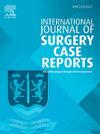A rare case of abdominal (lesser sac) myxoid liposarcoma: A case report
IF 0.6
Q4 SURGERY
引用次数: 0
Abstract
Background and importance
Myxoid liposarcomas (MLS) are genetically defined by DDIT3 gene fusions and most commonly arise in the extremities. They can also occur in the retroperitoneum as a primary site. However, there are controversies in its occurrence. It peaks in the fourth and fifth decades of life, affecting both gender equally.
Case presentation
A 38-year-old male patient presented with painless abdominal swelling, indigestion, and loss of appetite of 08 months duration. The abdominal examination showed a regular non-tender mass filling the left upper quadrant mimicking huge splenomegaly. An abdominopelvic ultrasound shows a huge echo complex mass filling the left upper abdomen. A contrast CT scan revealed a well-defined mass filling the lesser sac with a moderate mass effect on nearby abdominal organs with a clear fat plane and hence with no sign of invasion. Laboratory tests were found to be in the normal range except moderate anemia. Laparotomy was decided after case analysis and correction of anemia. A huge mass excised from the lesser sac and sent for histology. The patient went home on the third day after laparotomy. Histopathologic results reported retroperitoneal MLS with the classic microscopic findings.
Clinical discussion
MLS is the second most common type of liposarcoma, and tends to occur in the lower extremities. It rarely occurs in the retroperitoneum, with most cases being classified as atypical lipomatous tumors with prominent myxoid change.
Conclusion
It is crucial to differentiate a metastatic MLS originating from the lower extremities. The principle of treatment is complete surgical resection.
求助全文
约1分钟内获得全文
求助全文
来源期刊
CiteScore
1.10
自引率
0.00%
发文量
1116
审稿时长
46 days

 求助内容:
求助内容: 应助结果提醒方式:
应助结果提醒方式:


